Nilupak na Saging wasn't just a merienda, it was my summer business companion. Every April and May, while other kids were playing in the streets, I was in our kitchen with my Lola, pounding away at saba bananas in our old wooden lusong.
The rhythmic thud-thud-thud of the pestle became my summer soundtrack as I prepared batches to sell at our local palengke.
What started as a simple way to earn extra money for school supplies turned into a cherished connection to our Filipino food heritage. The magic moment was always watching my customers' eyes light up at the first buttery, coconutty bite - that same delighted expression I saw on my Lola's face years ago when she taught me this recipe.
Today, while modern kitchen gadgets can make the process easier, there's something special about making Nilupak na Saging the traditional way.
The satisfaction of transforming humble saba bananas into this velvety, coconut-infused delicacy is unmatched. This time-tested recipe brings the authentic flavors of rural Philippines right to your kitchen.
Jump to:
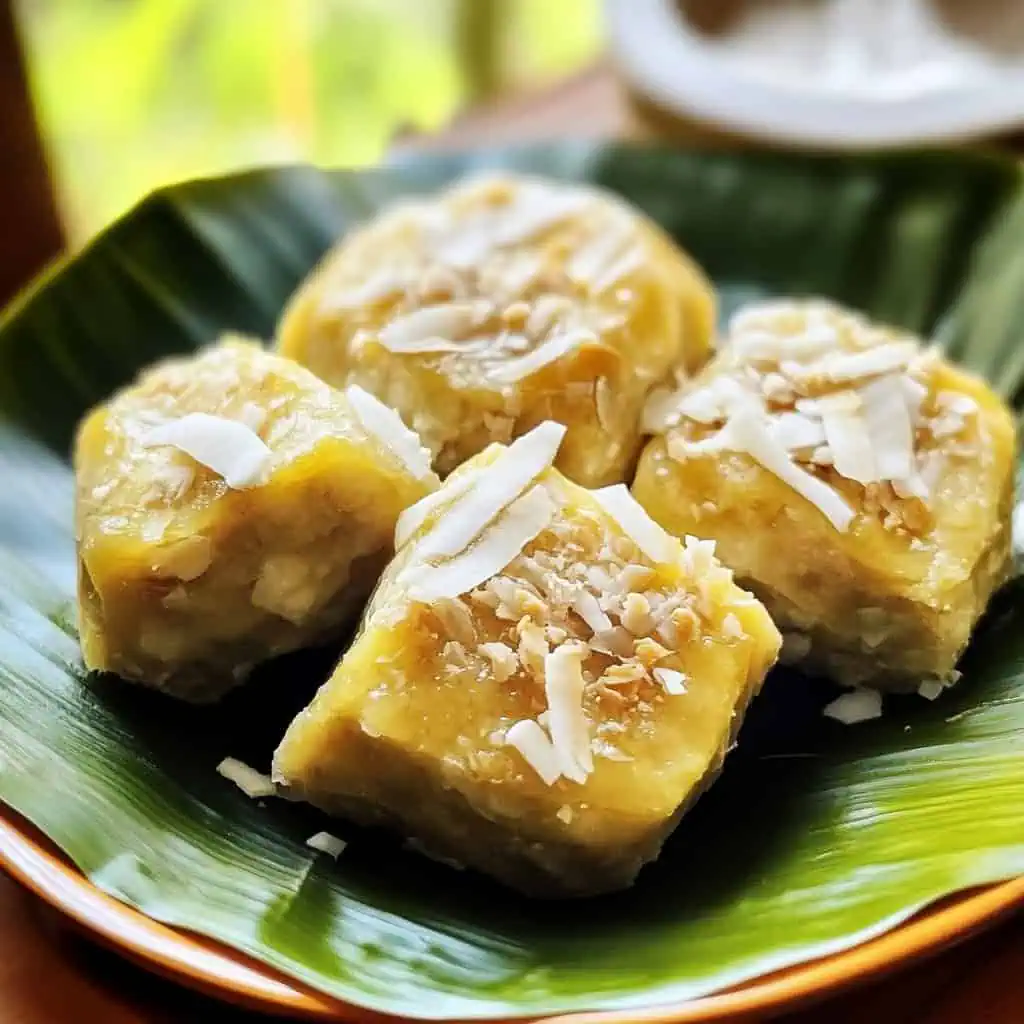
Why You'll Love This Recipe
- Authentic Filipino flavors passed down through generations
- Simple, wholesome ingredients
- Perfectly balanced sweetness and texture
- Great way to preserve traditional cooking methods
- Can be made with modern kitchen tools while maintaining traditional taste
- Perfect for merienda (afternoon snack) or dessert
Ingredients
The ingredients in Nilupak na Saging have been carefully selected for their harmonious combination of flavors and textures. Unripe saba bananas provide the perfect starchy base that holds together well when mashed. Freshly grated coconut adds natural sweetness, moisture, and a distinct tropical flavor that's quintessentially Filipino.
Brown sugar enhances the natural sweetness of the bananas while adding depth, and vanilla extract brings subtle warmth and aroma. The butter finish creates a rich, glossy top that melts into the warm dish.
Together, these simple ingredients create a deeply satisfying treat that showcases the beauty of traditional Filipino cooking – transforming humble components into something truly special.

- 15 pieces unripe saba bananas (slightly firm but not completely green)
- 1 whole coconut, freshly grated (approximately 2 cups)
- ½ cup brown sugar (packed)
- ½ teaspoon vanilla extract
- 4 tablespoons butter or margarine, softened
- Banana leaves for serving (optional)
Equipment
- Large Pot (Kaldero): For boiling the saba bananas until tender - a deep pot works best to ensure even cooking
- Wooden Mortar and Pestle (Lusong at Pangbayo): Traditional tool for achieving authentic texture through pounding; the wood absorbs some moisture and helps develop proper consistency
- Alternative Mashing Tools: Food processor or heavy-duty potato masher if wooden mortar unavailable
- Sharp Knife: For peeling bananas and cutting finished Nilupak into serving portions
- Measuring Cups and Spoons: For precise ingredient measurements
- Serving Platter: Preferably a wooden board or traditional banana-leaf-lined plate for authentic presentation
- Pastry Brush: For applying butter evenly across the top surface
- Small Pan: For wilting banana leaves if using them for presentation
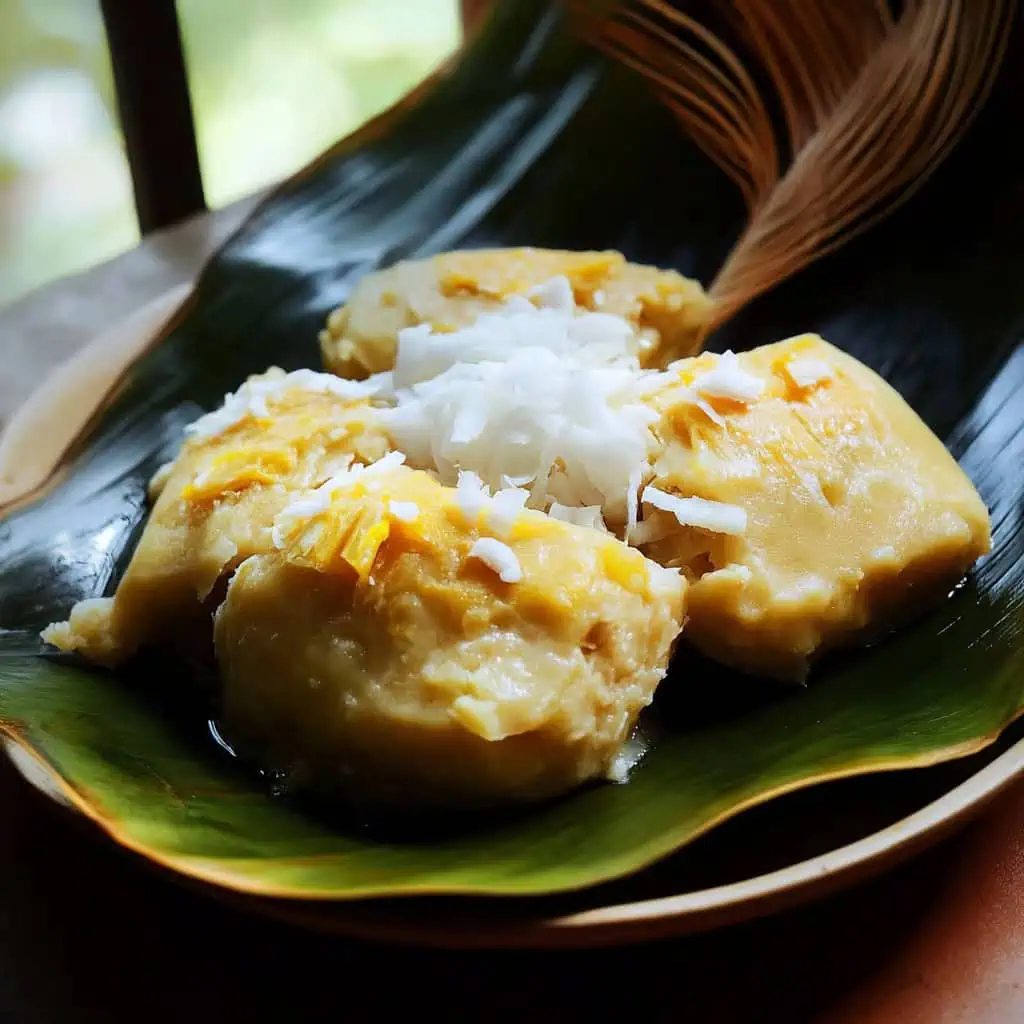
How To Make
- Prepare the Bananas: Peel all 15 saba bananas and place them in a large pot. Fill with enough water to cover the bananas completely. Bring to a boil over high heat (180°C/350°F).
- Cook Until Tender: Once boiling, reduce heat to medium (150°C/300°F) and cook bananas for 12-15 minutes. Test doneness by piercing with a fork - it should slide through easily. Drain all water and allow bananas to cool slightly until comfortable to handle.
- Mash the Bananas: Transfer cooked bananas to your wooden mortar or large bowl. Pound with pestle or mash with potato masher until completely smooth with no lumps remaining. Take your time with this step - the silky texture is crucial to authentic Nilupak.
- Combine Ingredients: Add freshly grated coconut to your mashed bananas. If using traditional method, continue pounding until well incorporated. Add brown sugar and vanilla extract. Continue pounding or mixing until all ingredients are evenly distributed and mixture is smooth.
- Prepare Serving Surface: For traditional presentation, quickly pass banana leaves over a flame or hot stove to make them pliable and bring out their natural shine. Wipe clean with a damp cloth and arrange on your serving plate.
- Shape and Finish: Transfer the mixture to your prepared serving plate. Shape into a dome or flatten to later cut into portions. Using a pastry brush, generously coat the top surface with softened butter or margarine.
- Portion and Serve: Cut the Nilupak into squares or diamond shapes. Serve while still warm for the best flavor experience, though room temperature serving is also traditional.

Tips from Lola's Kitchen
- Banana Selection: Choose saba bananas that give slightly when pressed but aren't soft - these provide the perfect starchy base
- Coconut Freshness: Whenever possible, use freshly grated coconut for superior flavor and moisture content
- Pounding Technique: Use consistent, firm pressure when pounding to develop the glutinous texture that defines great Nilupak
- Water Management: Keep your hands slightly damp (not wet) when shaping to prevent sticking
- Temperature Matters: Serve warm for traditional experience - the heat enhances the butter and coconut flavors
- Patience is Key: Don't rush the mashing process; thorough pounding creates the signature silky texture
- Banana Leaf Preparation: If using banana leaves, quickly pass over flame just until they become flexible and glossy, but don't burn
Substitutions
- Saba Bananas: If unavailable, use plantains (though texture will differ slightly) or a mix of plantains and regular bananas
- Fresh Coconut: Frozen grated coconut (defrosted and drained) works in a pinch
- Brown Sugar: Muscovado sugar adds depth, or use coconut sugar for a more traditional Filipino flavor
- Butter: Coconut oil creates a dairy-free version with complementary flavor
- Vanilla Extract: Pandan extract provides a uniquely Filipino aromatic quality
- Banana Leaves: Parchment paper brushed lightly with coconut oil can substitute for serving
Troubleshooting
- Mixture Too Wet: Add more grated coconut, 2 tablespoons at a time, until desired consistency is reached
- Mixture Too Dry: Incorporate 1-2 tablespoons coconut milk or regular milk until just moistened
- Too Sweet: Balance with additional unsweetened grated coconut to dilute sweetness
- Not Smooth Enough: Continue pounding or processing, adding a tiny amount of warm water if needed
- Butter Not Melting Properly: Ensure Nilupak is still warm when applying butter; if needed, warm butter slightly
- Sticking to Hands When Shaping: Keep hands lightly moistened with water or brush with a small amount of coconut oil
Storage & Reheating
- Refrigeration: Store in an airtight container in the refrigerator for up to 3 days
- Room Temperature: Allow refrigerated Nilupak to come to room temperature (about 30 minutes) before serving
- Gentle Reheating: If desired warm, place in a microwave-safe dish covered with a damp paper towel and heat on 50% power for 30-second intervals
- Refreshing: Brush refrigerated portions with fresh butter before serving to restore moisture and shine
- Freezing: Not recommended as the texture changes significantly and coconut can develop off-flavors
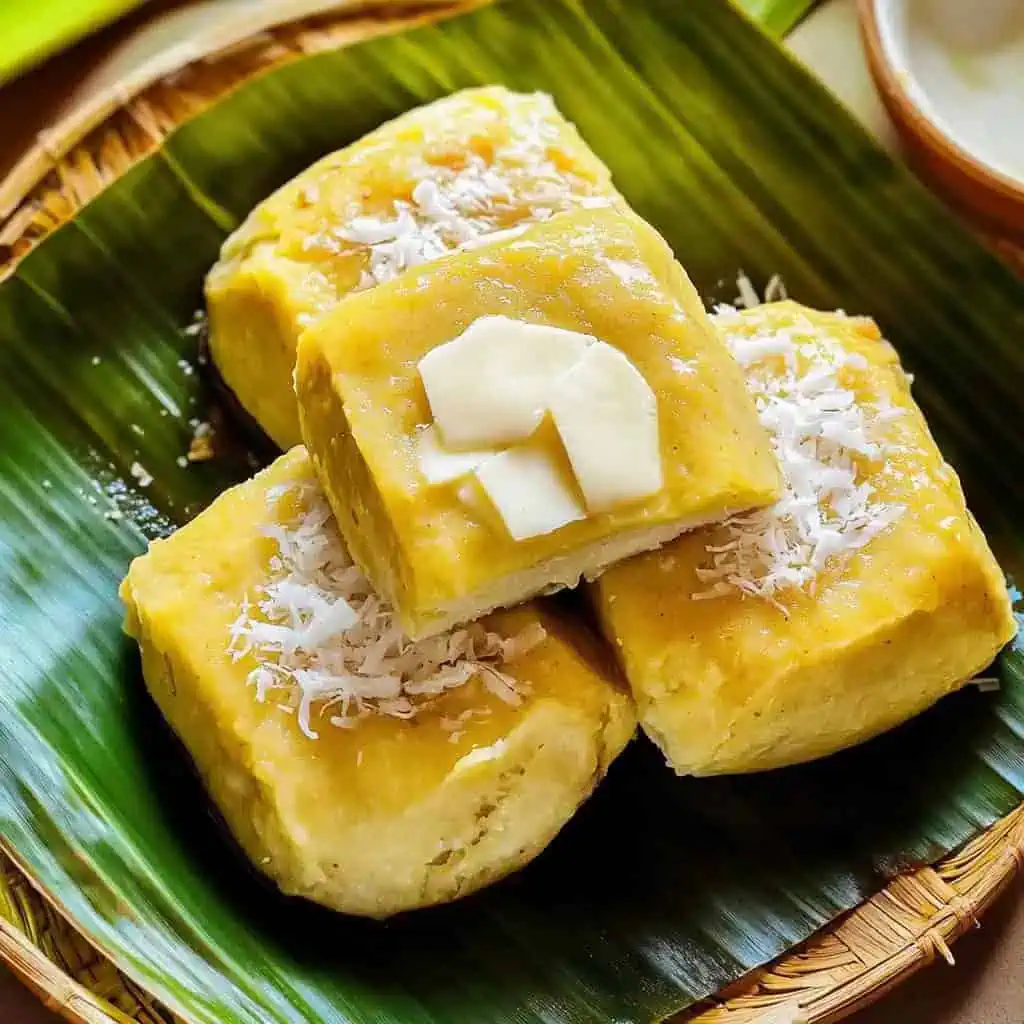
FAQ
Can I make Nilupak na Saging ahead of time?
While best served fresh, you can prepare it up to 24 hours in advance. Store covered in the refrigerator and bring to room temperature before serving.
Why use unripe saba bananas instead of ripe ones?
Unripe saba provides the proper starchy texture and controlled sweetness. Ripe bananas would make the mixture too soft and overly sweet.
Is Nilupak na Saging gluten-free?
Yes, this dish is naturally gluten-free, containing only bananas, coconut, sugar, and butter.
Can I use a food processor instead of hand-pounding?
Yes, though traditional hand-pounding creates the authentic texture. If using a food processor, pulse carefully to avoid over-processing.
How can I tell when saba bananas are properly cooked?
They should be fork-tender throughout but not mushy. A fork should slide in easily but the banana should not fall apart.
What makes Nilupak different from regular mashed bananas?
The specific technique of pounding rather than just mashing, combined with the addition of freshly grated coconut, creates the distinctive glutinous texture unique to Nilupak.
Can I add other flavors to Nilupak?
Traditional variations include adding pandan extract, toasted sesame seeds, or latik (coconut caramel). Start with small amounts to maintain authenticity.
Is this dessert very sweet?
No, authentic Nilupak balances sweetness with the natural flavors of coconut and saba. It's moderately sweet rather than sugary.
Related
Looking for other recipes like this? Try these:
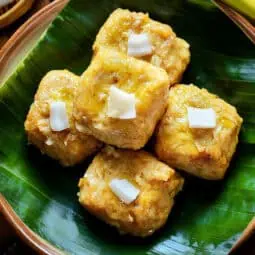
Nilupak na Saging (Filipino Mashed Banana)
Equipment
- Large pot (kaldero) for boiling bananas
- Wooden mortar and pestle (pangdikdik) traditional tool for mashing, Alternative: Food processor or potato masher
- Banana Leaves (Dahon ng Saging) for serving
- Sharp knife (panghiwa) for peeling bananas and cutting portions
- Measuring cups and spoons (Panukat) for precise measurements of ingredients
- Serving platter (bandehado) for serving
- Pastry brush for applying butter
Ingredients
- 15 pieces unripe saba bananas saging na saba
- ½ cup brown sugar asukal na pula
- 1 whole coconut freshly grated (niyog na kinayod)
- ½ teaspoon vanilla extract
- 4 tablespoons butter or margarine softened
- Banana leaves for serving optional
Instructions
- First, peel all 15 saba bananas and place them in a large pot. Fill the pot with enough water to cover all the bananas. Turn your stove to high heat (180°C/350°F) and bring the water to a boil.
- Once boiling, lower the heat to medium (150°C/300°F) and cook the bananas for 12-15 minutes. You can check if they're done by poking with a fork - it should go through easily. When they're tender, drain all the water and let the bananas cool slightly.
- Place the cooked bananas in your wooden mortar (lusong) or large bowl if using a potato masher. Pound or mash the bananas until completely smooth with no lumps. Take your time with this step to ensure a silky texture.
- Add the freshly grated coconut to your mashed bananas. If using the traditional method, continue pounding until well combined. Next, add the brown sugar and vanilla extract. Keep pounding or mixing until everything is evenly combined and smooth.
- If you're using banana leaves for serving, quickly pass them over a flame or hot stove to make them soft and shiny. Wipe them clean with a damp cloth. This step is optional but adds a wonderful traditional aroma.
- Transfer your mixture to a serving plate. Shape it into either a dome or flatten it to cut into squares later. Using a brush or spoon, generously coat the top with softened butter or margarine. If you prepared banana leaves, place them on your serving plate first, then add the linupak.
- Finally, cut your linupak into squares or diamond shapes. Serve while still warm for the best experience. You can enjoy it at room temperature too, but warm linupak has the most comforting texture and aroma.
- Remember to keep your hands slightly wet when shaping the mixture to prevent sticking. The whole process takes about 35 minutes, and the recipe serves 8-10 people.
Tips from Lola's Kitchen
- Use slightly underripe saba bananas for best texture
- Wilt banana leaves over fire or hot stove for authentic aroma
- Test banana doneness by piercing - overcooked bananas become watery
- For smoother texture, pound ingredients gradually
- Keep hands slightly wet when shaping to prevent sticking
Nutrition
The Story Behind Nilupak na Saging
Nilupak na Saging's story begins in the heart of rural Philippines, where resourceful home cooks transformed simple saba bananas into a beloved merienda that has graced Filipino tables for generations. This traditional delicacy originated from the practice of pounding ingredients in a wooden mortar and pestle, known locally as lusong at pangbayo, which gave birth to its name - "nilupak" coming from the Tagalog word "lupak," meaning to pound or mash.
In provinces like Quezon, Laguna, and Batangas, where saba banana trees flourish in abundance, Linupak became a practical way to use unripe bananas during harvest season. The dish exemplifies the Filipino culinary philosophy of turning humble ingredients into something extraordinary through time-honored techniques. Some regions refer to it as "Linuyang," highlighting how deeply embedded this dish is in local food culture.
What makes Linupak na Saging truly special is its role in Philippine family traditions. Often prepared during afternoon merienda gatherings, this dish became a symbol of community as families would share their homemade versions with neighbors. The rhythmic pounding sound of its preparation would echo through village streets, signaling to everyone that a comforting treat was in the making. Many Filipino elders recall helping their grandmothers prepare this dish, learning the precise technique of achieving that perfect, velvety texture that sets authentic Linupak apart.
Today, while modern kitchen appliances offer shortcuts, many Filipino families still prefer the traditional pounding method, believing it imparts a texture and flavor that machines simply cannot replicate. The dish remains a testament to Filipino ingenuity and the enduring appeal of our heritage recipes. Whether enjoyed as a midday snack or served during special occasions, Linupak na Saging continues to connect modern Filipinos to their culinary roots, proving that sometimes the simplest dishes carry the richest cultural significance.
As urbanization grows and fast food becomes increasingly prevalent, recipes like Nilupak na Saging serve as important cultural touchstones, preserving not just flavors but also the stories and traditions of Filipino rural life. This seemingly simple banana-based delicacy represents much more than just food - it's a piece of Filipino cultural heritage that continues to be passed down through generations, one mortar and pestle at a time.
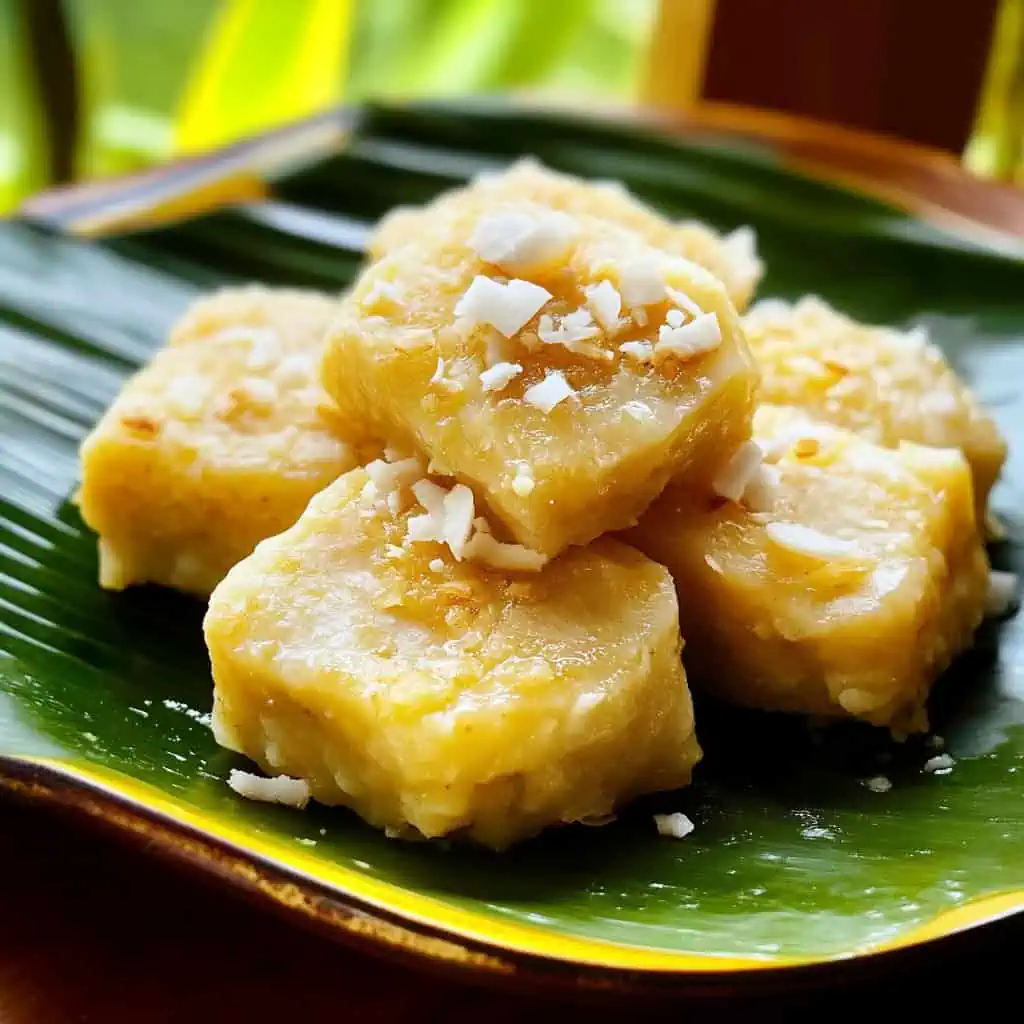






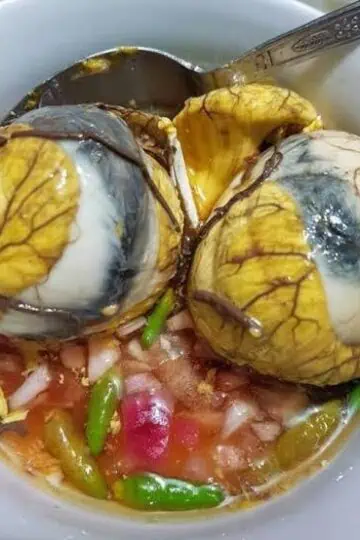
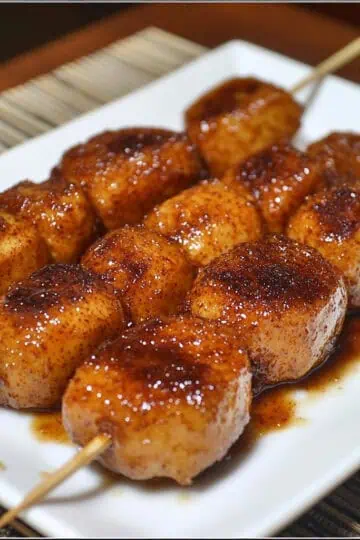
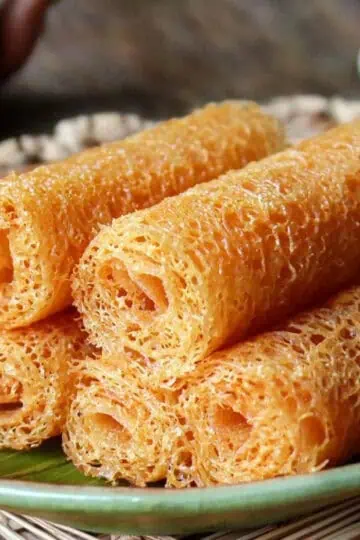
Comments
No Comments